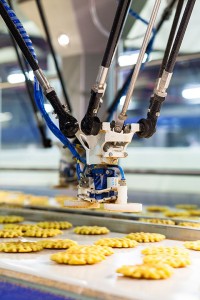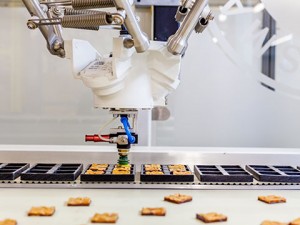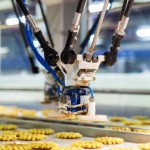Robots to shape the future of food manufacturing
 The adoption of robotics is set to change the face of food manufacturing for the better, both for primary and secondary processing and packaging tasks, as Paul Carter, robotics sales manager at FANUC UK, explains.
The adoption of robotics is set to change the face of food manufacturing for the better, both for primary and secondary processing and packaging tasks, as Paul Carter, robotics sales manager at FANUC UK, explains.
Many food producers still heavily reliant on manual labour and semi-automated equipment. Figures from the IFR 2022 World Robotics Industrial Robots Report show that only 3% of global industrial robot installations are for food and beverage applications, compared with 23% for automotive.
Fortunately, the tide is beginning to turn; global robot installations in the food and beverage industry grew by 12% year on year from 2016 to 2021. And in the UK, of the 2,054 industrial robot installations in 2021, 164 were in the food and beverage industry, representing a total of 8% – well above the global average.
Most robot installations in food production lines are for packaging, picking and placing tasks. However, there is a lot more that robots can do. Here, we look at four ways in which food production lines could look very different in 2033 thanks to the increased use of robots and automation:
Increased use of cobots
Lightweight and simple to use, collaborative robots, or cobots, are becoming increasingly popular within food factories, especially where space is restricted. Extremely slimline and with a base not much bigger than an A4 sheet of paper, they fit easily into crowded areas, such as loading/palletising environments, and can work alongside humans.
Despite their size, they lend themselves well to lifting applications, such as palletising and material handling tasks – the FANUC CRX-25iA, for example, has a 25kg payload and a 1,889mm reach. FANUC is continuing to develop its cobot range and in the future expects to see cobots with increasingly high payloads and longer reaches, to cope with growing customer demand.
 Less manual handling
Less manual handling
Since Covid and Brexit, labour shortages in the food industry have worsened and companies are looking to remove manual handling wherever possible. While a number of the individual processes in a food factory may already be automated, in many cases, people are still required to move products from one stage to another. Robots are ideally placed to help in these scenarios. Inherently flexible, they can easily be repurposed to cope with product changes enabling the factory to remain agile in the face of labour shortages.
Packing is another area which is traditionally very labour intensive. There is now a clear trend of using robots to pack ingredients into trays, trays into boxes and boxes onto pallets, freeing up human workers to carry out more value-added tasks. In the future, food factories will resemble automotive factories more and more, with robots carrying out the majority of manual handling tasks. There will also be an increased use of autonomous robot vehicles to move stock around the warehouse, and for loading/unloading.
AI-powered vision inspection systems
Another area which is ripe for automating is quality control. Robotic vision inspection systems using AI and machine learning can detect product faults quickly, accurately and reliably, helping to speed up production lines. This technology can also be used for product sorting and grading, for example potatoes. Repetitive, manual tasks such as this are ideal for being completed by AI-powered vision-guided robots, helping to free up valuable human employees.
Robots in the field
Finally, robots are moving out of the factory and helping to replace labour shortages in the fields. There are already trials of robots being placed onto tractors and incorporated with a vision system to inspect produce in the field. They can assess the stage of growth/ripeness, and then pick the fruit or vegetable when they’re ready to be harvested. Expect to see many more of these applications in the future.
Visit the FANUC website for more information
















